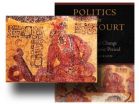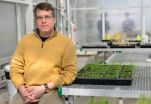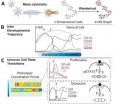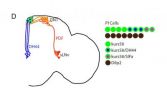(Press-News.org) If Facebook were around 1,400 years ago, the ancient Maya might have been big fans of the virtual self.
The Maya believed that part of your identity could inhabit material objects, like a courtier's mirror or sculptor's carving tool. Maya might even name these objects, talk to them or take them to special events. They considered these items to be alive.
The practice of sharing your identity with material possessions might seem unusual in a modern context.
But is it that different from today's selfie-snapping, candy-crushing online culture, where social media profiles can be as important to a person's identity as his or her real-world interactions? Even money is virtual now, as digital currency such as Bitcoin gains popularity.
Research by University of Cincinnati assistant professor Sarah Jackson is beginning to uncover some interesting parallels between ancient Maya and modern-day views on materiality.
"This relates to a lot of things that people are feeling out right now about virtual realities and dealing with computers and social lives online," says Jackson, an anthropological archaeologist. "These things start to occupy this uncomfortable space where we question, 'Is it real, or is it not real?' I look at the Maya context and consider, 'How different is that from some of the concerns we have now?' There are some parallels in terms of preoccupation with roles that objects play and how attached we are to things."
Jackson will present her research "Classic Maya Material Meanings (and Modern Archaeological Consequences)" on April 25 at the Society for American Archaeology's (SAA) annual meeting, which runs through April 27 in Austin, Texas. More than 3,000 scientists from around the world attend the event to learn about research covering a broad range of topics and time periods.
THE MAYA PERSPECTIVE
For her research, Jackson uses hieroglyphic textual evidence to help her understand how the Maya might have viewed the material world. She's building a database of Maya material terminology and tracking certain property qualifiers – visual markings on glyphs indicating from what material an object is made, like wood or stone.
Key to the process is trying to look at these property qualifiers from the Maya perspective. Jackson has found that the Maya applied property qualifiers in a broad manner, including some unexpected areas of divergence from literal interpretation.
For example, to the Maya, a temple might have "stony" qualities but so might a calendar or different things related to time. Other known Maya behaviors suggest belief in the concepts of object agency and partible personhood, meaning objects have the power to act in their own right and that the identity can be split into sections which can live outside the body.
So when Jackson analyzes a glyph that appears to show a Maya ruler having a conversation with his mirror or another that depicts a sculptor carving a "living" statue, it's important for her to overcome her own material assumptions.
"There are some really interesting possibilities if we can try to incorporate at least some kind of reconstructed understanding of how the Maya would have seen these materials, not just how we see them," Jackson says.
TRANSFORMING ARCHAEOLOGY
Jackson envisions potentially major changes in some fundamental aspects of archaeology, including the excavation process itself. She says even standard paperwork can encode certain assumptions and direct an archaeologist's interpretation in certain ways.
"It's really important to me that this isn't just abstract," Jackson says. "Let's see if we can think about how the Maya think, but let's also think about how this can transform what we're doing archaeologically."
Jackson plans to return to Belize next spring for additional field work, and she intends to test some experimental techniques. She's working with Christopher Motz, a doctoral student in UC's Department of Classics, to develop a database and interface for mobile tablet use in field work. The new technology is intended to allow researchers to catalog field data in a way that conveniently integrates traditional and new recording methods, similar to the innovative methods in use at UC's archaeological research project at Pompeii.
"Some of these things I'm thinking about could really shift how we characterize objects, how we record them, what is our vision of what they look like. And then how we construct ideas of assemblages, like how objects are relating to each other in a particular context and how we document them," Jackson says.
INFORMATION:
Jackson's research was supported by funding from the Taft Research Center.
MAYA AND POLITICS
Jackson's book "Politics of the Maya Court: Hierarchy and Change in the Late Classic Period" examines the important role of political advisers on the Maya court.
MORE MAYA RESEARCH AT UC
In addition to Jackson's work out of the McMicken College of Arts & Sciences, UC research on the ancient Maya is conducted by several faculty members across multiple disciplines.
The Ancient Maya and virtual worlds: Different perspectives on material meanings
A UC researcher explores the Maya perspective on the material world and begins to uncover parallels with today's online culture
2014-04-24
ELSE PRESS RELEASES FROM THIS DATE:
Autism Genome Project delivers genetic discovery
2014-04-24
NEW YORK, N.Y. (April 24, 2014) – A new study from investigators with the Autism Genome Project, the world's largest research project on identifying genes associated with risk for autism, has found that the comprehensive use of copy number variant (CNV) genetic testing offers an important tool in individualized diagnosis and treatment of autism.
Funded primarily by Autism Speaks, the world's leading autism science and advocacy organization, the Autism Genome Project involved more than 50 research centers in 11 countries. The report, published today in the American Journal ...
Measles commentary in Annals of Internal Medicine
2014-04-24
1. Measles outbreaks prompt concern about physician knowledge gaps
Vaccination refusal and importation of the disease has led to increased incidence of measles in the United States. Before widespread vaccination, approximately 500,000 measles cases occurred annually, resulting in 500 deaths and 48,000 hospitalizations. Vaccination programs helped to eradicate endemic measles by the year 2000, reducing the median number of cases per year to 60. But in just the first three months of 2014, 106 measles cases were reported, prompting health officials to become concerned. Measles ...
Plants send out signals attracting harmful bacteria, MU study finds
2014-04-24
COLUMBIA, Mo. – When bacteria attack plants, they often inject harmful proteins into the host plants' cells to weaken and suppress natural defenses. However, in some plants, bacteria attack once they've recognized the plant cells as a potential host. Now, researchers at the University of Missouri have identified and replicated the process that allows the bacteria—known mostly for attacking tomatoes—to invade its host. This discovery could lead to natural anti-infective treatments that work with food-producing plants to enhance resistance to harmful bacteria in the field.
"When ...
Genome yields insights into golden eagle vision, smell
2014-04-24
WEST LAFAYETTE, Ind. - Purdue and West Virginia University researchers are the first to sequence the genome of the golden eagle, providing a bird's-eye view of eagle features that could lead to more effective conservation strategies.
Their study calls into question long-held assumptions about golden eagle vision, indicating that the raptors may not be as sensitive to ultraviolet light as previously thought. The genome also suggests that golden eagles could have a sharper sense of smell than researchers realized.
Additionally, the genome provides thousands of genetic ...
International collaboration unravels novel mechanism for neurological disorder
2014-04-24
HOUSTON – (April 24, 2014) – A team of international scientists led by Baylor College of Medicine has discovered a novel gene (CLP1) associated with a neurological disorder affecting both the peripheral and central nervous systems. Together with scientists in Vienna they show that disturbance of a very basic biological process, tRNA biogenesis, can result in cell death of neural progenitor cells. This leads to abnormal brain development and a small head circumference as well as dysfunction of peripheral nerves.
The study published today in the current issue of the journal ...
Researchers create comprehensive map of human B cell development
2014-04-24
New York, NY - In the April 24, 2014 edition of Cell, a team of researchers led by Dana Pe'er at Columbia University and Garry Nolan at Stanford University describes a powerful new method for mapping cellular development at the single cell level. By combining emerging technologies for studying single cells with a new, advanced computational algorithm, they have created the most comprehensive map ever made of human B cell development. Their approach will greatly improve researchers' ability to investigate development in cells of all types, make it possible to identify rare ...
Surprising new insights into the PTEN tumor suppressor gene
2014-04-24
BOSTON – Ever since it was first identified more than 15 years ago, the PTEN gene has been known to play an integral role in preventing the onset and progression of numerous cancers. Consequently, when PTEN is either lost or mutated, malignant cells can grow unchecked and cancer can develop.
Now a team led by investigators at Beth Israel Deaconess Medical Center (BIDMC) helps explain more precisely how PTEN exerts its anti-cancer effects and how its loss or alteration can set cells on a cancerous course. The new study, which reveals that PTEN loss and PTEN mutations are ...
Researchers pinpoint protein crucial for development of biological rhythms in mice
2014-04-24
Johns Hopkins researchers report that they have identified a protein essential to the formation of the tiny brain region in mice that coordinates sleep-wake cycles and other so-called circadian rhythms.
By disabling the gene for that key protein in test animals, the scientists were able to home in on the mechanism by which that brain region, known as the suprachiasmatic nucleus or SCN, becomes the body's master clock while the embryo is developing.
The results of their experiments, reported online April 24 in Cell Reports, are an important step toward understanding ...
Oldest pterodactyloid species discovered, named by international team of researchers
2014-04-24
WASHINGTON—An international research team, including a George Washington University (GW) professor, has discovered and named the earliest and most primitive pterodactyloid—a group of flying reptiles that would go on to become the largest known flying creatures to have ever existed—and established they flew above the earth some 163 million years ago, longer than previously known.
Working from a fossil discovered in northwest China, the project—led by University of South Florida (USF) paleontologist Brian Andres, James Clark of the GW Columbian College of Arts and Sciences ...
Fruit fly study identifies brain circuit that drives daily cycles of rest, activity
2014-04-24
PHILADELPHIA - Amita Sehgal, PhD, a professor of Neuroscience at the Perelman School of Medicine, University of Pennsylvania, describes in Cell a circuit in the brain of fruit flies that controls their daily, rhythmic behavior of rest and activity. The new study also found that the fly version of the human brain protein known as corticotrophin releasing factor (CRF) is a major coordinating molecule in this circuit. Fly CRF, called DH44, is required for rest/activity cycles and is produced in cells that receive input from the clock cells in the fly brain. In mammals, CRF ...
LAST 30 PRESS RELEASES:
Numbers in our sights affect how we perceive space
SIMJ announces global collaborative book project in commemoration of its 75th anniversary
Air pollution exposure and birth weight
Obstructive sleep apnea risk and mental health conditions among older adults
How talking slows eye movements behind the wheel
The Ceramic Society of Japan’s Oxoate Ceramics Research Association launches new international book project
Heart-brain connection: international study reveals the role of the vagus nerve in keeping the heart young
Researchers identify Rb1 as a predictive biomarker for a new therapeutic strategy in some breast cancers
Survey reveals ethical gaps slowing AI adoption in pediatric surgery
Stimulant ADHD medications work differently than thought
AI overestimates how smart people are, according to HSE economists
HSE researchers create genome-wide map of quadruplexes
Scientists boost cell "powerhouses" to burn more calories
Automatic label checking: The missing step in making reliable medical AI
Low daily alcohol intake linked to 50% heightened mouth cancer risk in India
American Meteorological Society announces Rick Spinrad as 2026 President-Elect
Biomass-based carbon capture spotlighted in newly released global climate webinar recording
Illuminating invisible nano pollutants: advanced bioimaging tracks the full journey of emerging nanoscale contaminants in living systems
How does age affect recovery from spinal cord injury?
Novel AI tool offers prognosis for patients with head and neck cancer
Fathers’ microplastic exposure tied to their children’s metabolic problems
Research validates laboratory model for studying high-grade serous ovarian cancer
SIR 2026 delivers transformative breakthroughs in minimally invasive medicine to improve patient care
Stem Cell Reports most downloaded papers of 2025 highlight the breadth and impact of stem cell research
Oxford-led study estimates NHS spends around 3% of its primary and secondary care budget on the health impacts of heat and cold in England
A researcher’s long quest leads to a smart composite breakthrough
Urban wild bees act as “microbial sensors” of city health.
New study finds where you live affects recovery after a hip fracture
Forecasting the impact of fully automated vehicle adoption on US road traffic injuries
Alcohol-related hospitalizations from 2016 to 2022
[Press-News.org] The Ancient Maya and virtual worlds: Different perspectives on material meaningsA UC researcher explores the Maya perspective on the material world and begins to uncover parallels with today's online culture







